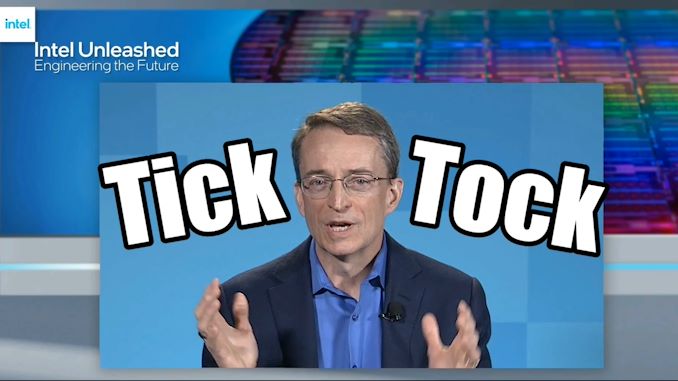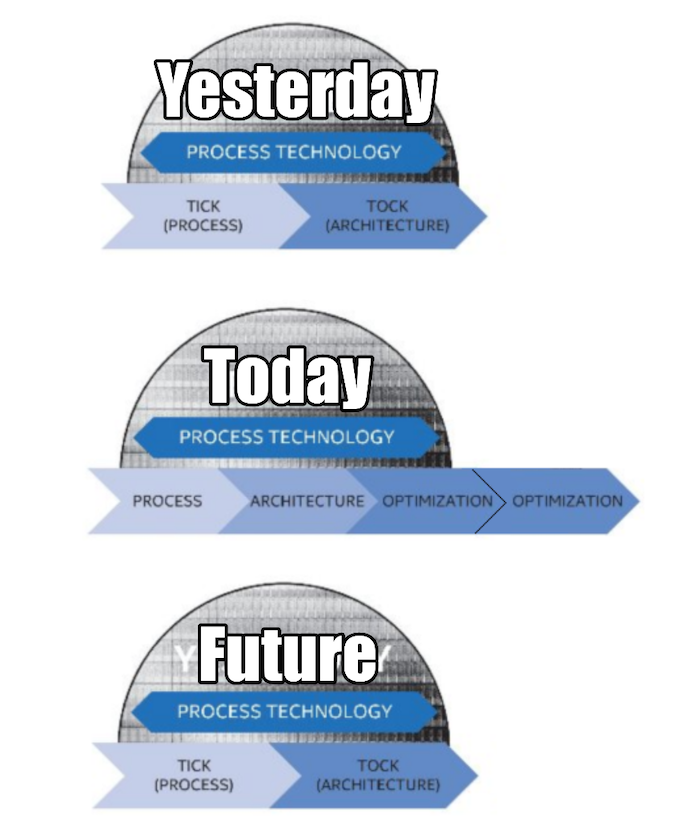Intel to Revive ‘Tick-Tock’ Model, Unquestioned CPU Leadership Performance in 2024/2025
by Dr. Ian Cutress on March 23, 2021 6:31 PM EST- Posted in
- CPUs
- Intel
- Tick-Tock
- 7nm
- Chiplets
- Pat Gelsinger
- Meteor Lake
- Tiles

As part of today’s announcements, during Intel’s Q&A session after the prepared remarks, CEO Pat Gelsinger explained how Intel is going to revive its fortunes when it comes to its leading edge compute products. One of Gelsinger’s mantras seems to be that unquestioned leadership products bring unquestioned leadership margins for those products, and for Intel to execute, it needs to return to its days of old.
In the past, through the 1990s, 2000s, and into the 2010s, Intel’s manufacturing philosophy was known as ‘Tick-Tock’. This means that for every product generation, the leading edge compute hardware was either a Tick (process node enhancement), or a Tock (microarchitecture enhancement). Each generation would alternate between the two, allowing Intel to take advantage of a familiar design on a new process node, or using a mature node to enable a new performance-focused design. That policy was scuppered when delays to Intel’s 10nm forced Intel into more of a Tick-Tock-Optimization-Optimization-Optimization model.
Today CEO Pat Gelsinger stated that at Intel’s core it has to re-establish the Tick-Tock model that enabled repeated leadership in the CPU ecosystem, buoyed by a healthy CPU roadmap. Part of this is re-establishing discipline in Intel’s ranks to continually provide both microarchitecture updates and process node updates on a regular expected cadence. Pat stated as part of the call that Intel will look towards a confirmed yearly process node improvement, and as a result, there might be a lot of Ticks in the future, with a push to more Tocks as well.
On top of this commentary, Pat Gelsinger also stated that Intel’s CPU roadmaps are already baked in through 2021, 2022, and 2023. The company is thus looking to 2024/2025 for ‘unquestioned CPU leadership performance’, which traditionally means the fastest processor for single thread and multi-thread workloads. This is for sure a laudable goal, however Intel will also have to adapt to a changing landscape of chiplet processor designs (coming in 2023), enhancing on-die accelerators (GNA already present), and also what it means to have leadership performance – in the modern era, leadership performance doesn’t mean much if you’re also pushing lots of Watts. Intel stated that its 7nm process is now comfortably on track to deliver Meteor Lake, a client CPU using tiles/chiplets, in 2023, however we are likely looking to a 7nm variant or even external processes for a 2024/2025 product. Intel has also stated that it is looking to consider the core of its leading edge compute on external foundry processes, although one might argue that this doesn’t explicitly say ‘CPU’.
It is also worth noting that Intel/Gelsinger isn’t calling its disaggregated silicon as ‘chiplets’, and prefers to use the term ‘tiles’. This is because Intel’s tiles amount to long wires across 3D packaging technologies like EMIB and Foveros, compared to package-based multi-die interconnect that require buffers as well as control fabric. Tiles by this definition are more costly to implement than chiplets, and have additional thermal considerations by having high-powered silicon close together, so it will be interesting to see how Intel balances these new packaging technologies with the more cost-sensitive elements of its portfolio, such as client processors.
It’s been known that Intel’s microarchitecture teams haven’t been idle waiting for 10nm to come through the pipe, with a number of designs ready and waiting to go for when the process node technology matures. With any luck, if Intel can get a headwind with 7nm, when 2024 rolls around it might all come thick and fast.











109 Comments
View All Comments
Sivar - Wednesday, March 24, 2021 - link
"In the past, through the 1990s, 2000s, and into the 2010s, Intel’s manufacturing philosophy was known as ‘Tick-Tock’."Tick-Tock wasn't named until the Core architecture in 2006 not 2007, was it?
Spunjji - Friday, March 26, 2021 - link
CorrectTheJian - Friday, March 26, 2021 - link
https://www.tweaktown.com/news/77583/tsmc-will-mak...Click the pics to blow them up.
https://www.forbes.com/sites/patrickmoorhead/2021/...
Perhaps far more important than previous link, but I might be biased. I've been following patrick since, jeez, never mind, I'm old. Let's just say decades and leave it at that. He's #1. Just saying. Make of those two links what you will and remember Anandtech was (is? don't come here much today) an AMD portal site. ;)
Spunjji - Friday, March 26, 2021 - link
"remember Anandtech was (is? don't come here much today) an AMD portal site"You seem to be casually referring to when they had a specific AMD section for AMD-sponsored news. Do you see that here anymore?
It's been good not seeing your posts around here. Don't let us persuade you not to stay away!
dsplover - Saturday, March 27, 2021 - link
They’re trolling AMD.In 2022 tick-tock will happen and take the world by surprise.
Until then if you absolutely need something new Intel CPUs are cheap cheap cheap.
Qasar - Saturday, March 27, 2021 - link
i will believe anything intel says, if and when it happens.Oxford Guy - Saturday, March 27, 2021 - link
He could have added 'and we're going to make overclocking really really good again, too'.After all, if one can magically restore the cadence with which process nodes can shrink to be what it used to be (ignoring those pesky laws of physics), why not add that symptom of that cadence?
I am far from an expert in node tech but I recall the statements from experts, like:
• The complexity goes way up as the nodes shrink. This manifests as 'design rules'. That means added cost (financial and time) and difficulty. More and more design rules appear with each node shrink. This obviously means that unless the company becomes bigger and is able to execute all of this added complexity just as quickly as it could execute the less complexity before, things will slow down.
• Silicon is marching toward the point of returns so diminished that a different material will have to be used. This angle on the problem is more speculative but we have seen the death of overclocking, the spewing of cores/chiplets as a kludge, the lack of progress past 5 GHz, increasingly power-hogging parts requiring now only solder but thinner substrates, etc.
watzupken - Sunday, March 28, 2021 - link
I am not sure if tick tock is still feasible when its going to be even more challenging shrinking from 7nm to 5nm, so on and so forth. They already struggled with 10nm and with the experience gained, still struggled to deliver 7nm in 3 years, so I don't expect any miracle again with the new CEO. In addition, considering that AMD's Zen 2 and Zen 3 are utilizing the same 7nm, and introduced performance improvements more on the "tock" cycle in both instances, I think this tick-tock strategy may likely struggle.